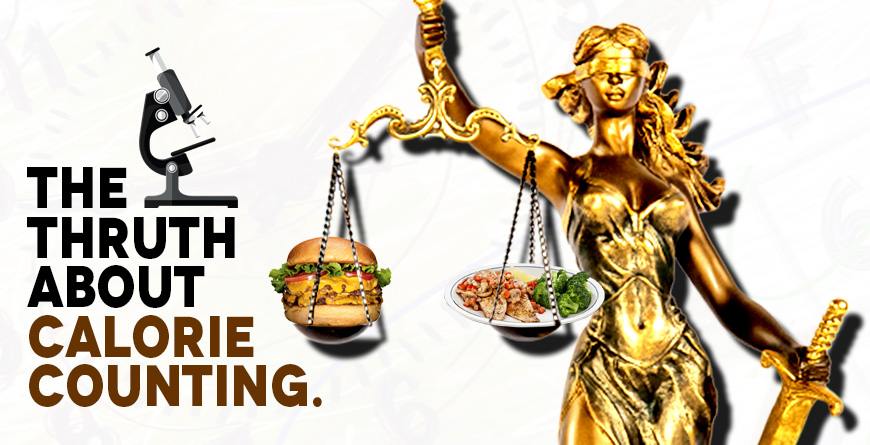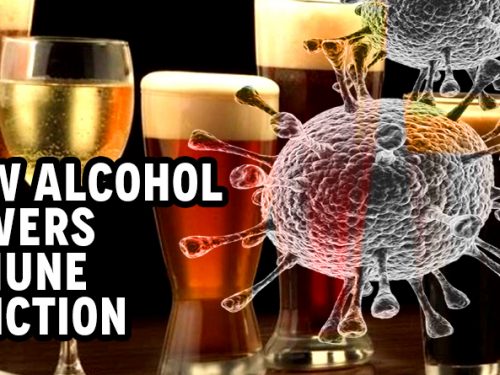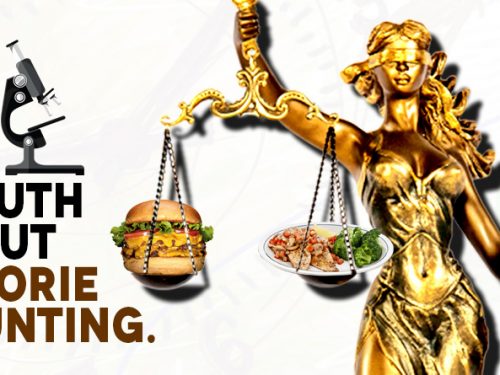
How using a flawed calorie measurement can cost you your health!
Humans love counting, we have a fascination with numbers because they often provide the backbone for science. The health and fitness industry, bodybuilding included loves numbers. It provides a way to measure our input, how much we squat or bench press, how many reps we perform, how many calories, how many grams of protein, carbohydrates and fats we consume over the course of a day.
For this article I want to focus on calorie counting, and why you should not be relying on a measurement system that was invented in the 1800’s! Yes, it was created way back then, when science was in its infancy.
In fact, the Calorie only began to enter popular American vocabulary after Atwater explained the unit in his 1887 article in Century magazine. It gained popularity when it was introduced in the USDA Farmers’ Bulletins, which provided the first U.S. food databases to be used in dietetics. Then, it became a victim of commercialization, as it was introduced to American audiences interested in managing weight, and the Calorie was soon introduced in many articles and books. Eventually, the Calorie was adopted for the nutrition facts panels on U.S. food labels.
What is a calorie?
Before we go any further let me explain what a calorie is. In order to answer this question, it makes sense to define the calorie. A calorie supposedly a unit that is used to measure energy. The Calorie you see on a food package is referred to, as a kilocalorie, or 1,000 calories. A Calorie (kcal) is the amount of energy needed to raise the temperature of one kilogram of water one degree Celsius. Sometimes the energy content of food is expressed in kilojoules (kj), a metric unit. One kcal equals 4.184 kj. However, the Calorie on a food package is 1,000 times larger than the calorie used in chemistry and physics.
The original method used to determine the number of kcals in a given food directly measured the energy it produced.The food was placed in a sealed container surrounded by water, an apparatus known as a bomb calorimeter. The food was completely burned and the resulting rise in water temperature was measured. This method is not frequently used today.
According to the National Data Lab (NDL), most of the calorie values in the USDA and industry food tables are based on an indirect calorie estimation made using the so-called Atwater system. In this system, calories are not determined directly by burning the foods. Instead, the total caloric value is calculated by adding up the calories provided by the energy-containing nutrients: protein, carbohydrate, fat and alcohol. Because carbohydrates contain some fiber that is not digested and utilized by the body, the fiber component is usually subtracted from the total carbohydrate before calculating the calories.
The Atwater system uses the average values of 4 Kcal/g for protein, 4 Kcal/g for carbohydrate, and 9 Kcal/g for fat. Alcohol is calculated at 7 Kcal/g. (These numbers were originally determined by burning and then averaging.) Thus the label on an energy bar that contains 10 g of protein, 20 g of carbohydrate and 9 g of fat would read 201 kcals or Calories.
Today many of us want to monitor our calorie consumption in order to lose or maintain our weight. Atwater, the son of a Methodist minister, was motivated by the opposite concern, at a time when malnutrition was widespread issue, he sought to help poor people find the most cost effective items to fill themselves up! We are already starting to see the cracks in the calorie measurement.
The count is off
Keep in mind his research was pioneering stuff for the 1890s. But the BIG question is, why are we still using a system that was created in the 1800’s? Who knows, but Atwater eventually concluded that a gram of either carbohydrate or protein made an average of four calories of energy available to the body, and a gram of fat offered nine calories. The problem was, and still is, the calorie measurement system does not account for the amount of energy the body uses to digest a particular food, or more importantly the true content (nutritional value) of a particular food!
The truth is, we now know far more about the complex workings of the human body. Atwater was right that some of a meal’s potential energy was excreted, but had no idea about the energy used to digest the meal itself, and that the body expends different amounts of energy depending on the food. Yet more than a century after this flawed measurement was created, the numbers Atwater calculated for each macronutrient remain the standard for measuring the calories in any given food stuff.
A Calorie is a Calorie
Sadly, Atwater transformed the way the public thought about food, with his simple belief that “a calorie is a calorie”. He actually went as far as counselling the poor against eating too many leafy green vegetables because they weren’t sufficiently dense in energy! The very foods that enhance general health, longevity and assist with weight loss. According to Atwater, it made no difference whether calories came from chocolate or broccoli, if the body absorbed more energy than it used, then it would store the excess as body fat, causing you to put on weight.
Commercialized Calories
The whole idea of measuring calories captured the public imagination. Back in 1918 the first book was published in America based on the simple notion that a healthy diet was no more complicated than the simple addition and subtraction of calories. “You may eat just what you like – chocolate, french fries, cake, burgers, pizza, icecream but count your calories!” The book was by Lulu Hunt Peters, titled “Diet and Health”. The crazy thing, the book sold millions. Just shows you how easy it is to manipulate public consensus, especially when you give them exactly what they want! The anything goes diet.
Let the Fat Wars Begin!
Fat became the Darth Vader of nutrition. Because the numbers said so, at 9 calories per gram it was the obvious nutritional villain! Atwater’s calorie calculations were an unwitting ally because counting calories was seen as an objective measure of the health qualities of any given food! Surely it was logical that the most calorie-laden part of any food item, fat, must be the enemy.
The public didn’t resist, they joined the Dark-Side in droves. Basing their diets on dishes low in calories, but high in sugar and carbohydrates, seemed the smartest approach. It became common practice to blame fat for many of the health illnesses of modern life, fueled by the sugar lobby, who, were found to have secretly funded studies at Harvard University designed to blame fat for the growing obesity epidemic. I mean, science can’t be wrong!
The Fat Lie
No disrespect, there are some smart people out there that understand that scientific studies can be manipulated, for a price! But some choose to hang on to “Everything” that has a study attached to it. You have to feel sorry for this type of mind-set, they must think the World is all about truth, honesty and doing the right thing by everyone!
I must say, the wool was plentiful to pull over the eyes of the public when it came to the fat wars. All that saggy stuff on our bellies was fat, and that fat we eat, must simply make us fatter.
Those of us who have even a little understanding of nutrition, know that we need EFAs ( Essential Fatty Acids) to maintain optimum health, produce hormones, maintain healthy skin, immune system, cell integrity, etc. The term “Essential” refers to the fact that our bodies can’t produce it, and we must supply it through dietary or supplementary means. Much like EAAs (Essential Amino Acids) the building blocks of protein. Sad to say, there is no such thing as an essential carbohydrate! This brings us to the next point.
All things are NOT Equal!
For the quiet observer, and nutritionally challenged it’s easy to get confused. Why, because at first glance, if we just go by “The Numbers”, fat does look like the bad guy, because it contains over double the calories of protein and carbohydrates. Once again, protein and carbs do appear “Equal” because, you guessed, they both contain the same amount of calories – 4cals per gm. Surely they must be equal, even some dieticians still think they are, but we have to forgive them because they have been fed by the cookie cutter (Science said so) universities!
The Reverse Pyramid
Event the World Health Organization it wrong, they had the pyramid upside down. Advising we eat tiny amount fats and protein and copious servings of carbohydrates! This upside down pyramid was the pioneer of the obesity epidemic we are seeing across the World today. Got to give them some credit, they did try and flip it around to reflect some better ratios but they damage had already been done.
The Simple Solution
Stop counting calories, and start counting nutrients! No more obsessing over numbers, all you need is a clear understanding of the nutritional value of foods, and how it reacts in the body. I mean seriously, when I hear so called fitness people talk about calorie-deficit, and this child-like analogy of calories in, calories out it makes me cringe. Is it possible to be that dumb, with all the information we have available at a keyboard level these days?
I guess it is, if we base our opinions and beliefs on “snippets” of information, or we just choose to run the the “mass consensus” just to fit in!
The truth is, many fitness folk run with what suits their taste buds, not their nutritional needs. Yeah, let’s just run out and eat anything as long as we don’t exceed our daily calorie limit. Makes zero sense, but it tastes great. Personally I like to live by example, I practice what I preach. I also apply logic to everything that I do, and if somethings not working, I change it, and move forward. Human beings are great at self justifying, we just love to it because it’s easy. Why would you want to work hard, when you can do it easy?
Dumb plans never get any smarter, no matter how hard you work them!
If it’s not working, the chances are it never will. So why keep following a dumb plan? Is it in the hope that one day, you wake up and it actually worked! Attaining great health and fitness, and building a great physique requires much more than a paint-by-numbers approach. It requires an in depth understanding of nutrition, exercise, supplementation and syncing it all up with a winning mindset. If you choose to take the road most travelled, the chances are you will end up like everyone else. That’s why success is limited to those that seek the road least travelled. It may entail a little hard work, some thinking and consistency, but the rewards are life changing.
Don’t count on success, they way you count on calories, because your future by indeed be as empty as the calories you consume.
– Steve Jones
P.S ( If you want to read learn more about the whole calorie deficit idea, check out my free ebooks CLICK HERE )
Author
The Aesthetic Bible
Design a Human Masterpiece
-
Books & Programs
The Aesthetic Bible Hard Cover Book
$77.95 – $79.95The Aesthetic Bible by Steve Jones – Hard Cover Book
Designing a Human Masterpiece – Compiles over 38 years of Steve’s knowledge in the fitness and bodybuilding industry in an A to Z quality Hardcover book. Discover how to train, eat, supplement and think to unleash your true aesthetic potential.
Over 240 pages of life changing content, including inspirational images, educational graphics, exercise programs, diet plans and guides!
NOTE: This is a high quality Hardcover Book, weighs 1kg (2.2lbs).












